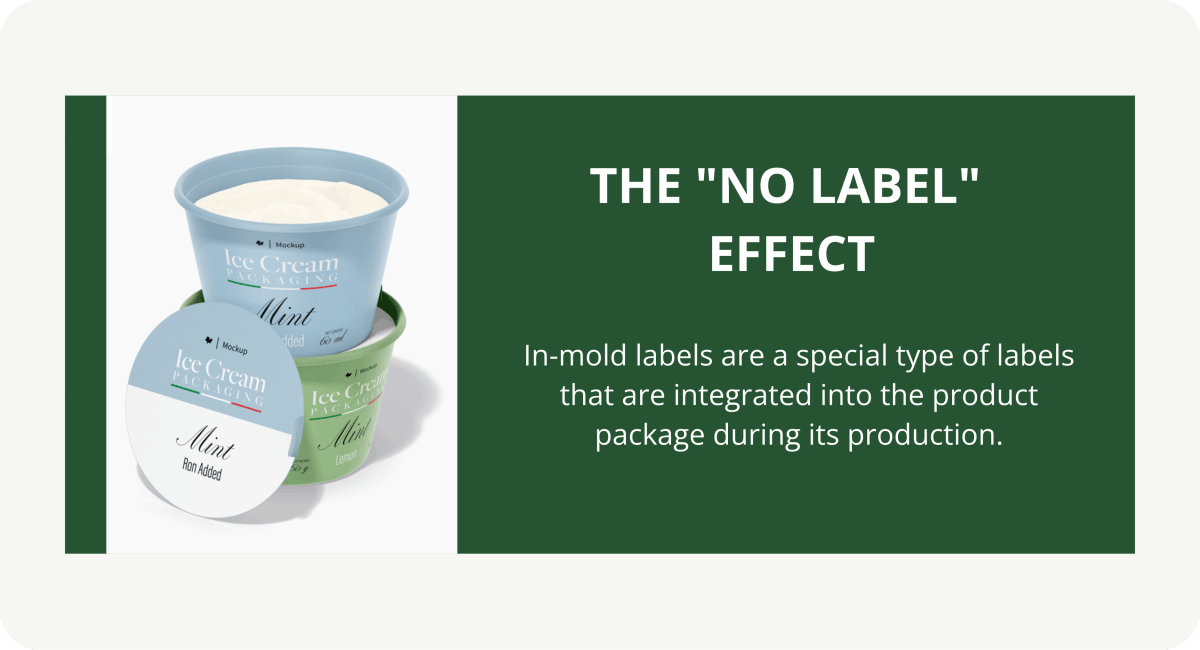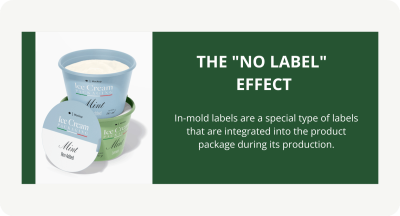Date: 26 Oct 2023
 In-mold anti-counterfeiting product labels are a successful labeling solution that has been gaining popularity in recent years. Also called IML labels, they are produced using a special technique which allows the labels to be embedded into the plastic package during its production.
In-mold anti-counterfeiting product labels are a successful labeling solution that has been gaining popularity in recent years. Also called IML labels, they are produced using a special technique which allows the labels to be embedded into the plastic package during its production.
This blog article will explore in more detail how in-mold labels are produced, their main advantages, disadvantages and applications.
What are IML labels and how are they made?
In-mold labelling (IML) is a method in which a pre-printed and label-shaped decorative film is placed into an injection mold before the plastic packaging takes its final form. The result is a uniform, beautifully decorated product that eliminates the need for subsequent labelling and enhances the appearance of the product.
Materials for IML production
The IML method primarily uses two types of plastic materials: high-density polyethylene (HDPE) and polypropylene (PP). These serve as the basis for creating bright and durable labels that are an integral part of the finished product.
IML labeling technologies
This type of labeling process is done using one of the following three methods: injection molding, blow molding and thermoforming. Regardless of technique, the basic principle remains unchanged: the label becomes one with the plastic packaging during production.
- Injection molding
This is the most commonly used labelling method in injection molding. Here's how it works:
- A specially designed label is placed in the open cavity of the injection mold, holding it in place by air pressure or mechanical means.
- The plastic material is heated and injected into the mold cavity where it cools.
- It is bonded permanently to the pre-applied label, resulting in a plastic package decorated with a design.
Injection molding offers design flexibility, cost-effectiveness and durable labelling solutions.
- Blow molding
- Similar to injection molding, the label is placed in the mold cavity.
- The plastic material is heated and stretched into a tube which is inserted into the mold.
- Air is blown into the tube, causing it to fill the mold cavity and assume its shape.
- Heat activates the label adhesive, which bonds to the plastic as it cools.
This technology is versatile and results in extremely durable plastic packaging.
- Thermoforming
It is mainly used for very rigid plastic packaging:
- Plastic sheets are heated and stretched into a unique shape using a molding tool.
- Before they cool and harden, a printed label is applied to the mold.
- When the plastic sheets are cooled and cured, they bond to the label, creating a fully decorated plastic part.
 Main advantages of in-mold labels
Main advantages of in-mold labels
IML labelling has many advantages that make it a popular technology in the packaging world.
- Excellent design quality and high-resolution printing: IML enhances the visual appeal of your packaging by supporting a very wide range of colors and decorating all sides of your packaging. As the labels become one with the product packaging during production, in-mold labels achieve the desired "no label" effect.
- Unmatched durability: these labels are designed to withstand very aggressive environments. Their water resistance makes them ideal for damp and wet production facilities, and they do not change their properties in very low or high temperatures including deep freeze and chill conditions. They also guarantee outstanding resistance to abrasion and scratching. Depending on the coatings used, the products can also withstand treatment with chemicals.
- Environmentally friendly: combining the packaging and label without additional adhesive makes IML plastic products more environmentally friendly and completely recyclable (depending on the type of plastic used). This characteristic reduces the product's carbon footprint and its impact on the environment.
- Cost-effectiveness: mass production occurs easily with IML technology as it combines the packaging production and decoration in one step. This streamlines the process, reduces labor costs and helps to use less floor space in production facilities and label supplier warehouses. In addition, the IML method eliminates the need for paper labels and adhesives, which further increases cost-effectiveness for large production runs.
- Counterfeit protection: The unique design of in-mold labels and the complex production process act as counterfeit protection. The variations in form design, foil printing and label forming processes make exact copying almost impossible, thus preserving the originality of your brand.
Main disadvantages of in-mold labels
It is also important to share a few disadvantages associated with in-mold labeling.
- The tooling and machines required for IML can be quite expensive, which can increase overall production costs.
- The IML method requires longer production runs due to the high costs associated with shorter runs and extended setup times, making it less suitable for smaller production projects.
Despite these limitations, the many advantages of IML often outweigh the disadvantages for industries seeking to achieve premium packaging and labeling solutions.
Applications
IML labels are used for a variety of applications in a wide range of industries:
- Personal care products such as shampoo bottles, deodorants and soaps;
- Food packaging such as tubs for ice cream and yogurt, as well as containers for soups, salads and pastries;
- Cosmetic tubes for sunscreen, cream and make-up;
- Household products such as cleaning agents, laundry detergent, soap dispensers and many more.
In summary, in-mold labelling is an innovative process where IML labels are incorporated into the product packaging during its manufacture. It improves the quality, appearance and performance of plastic packaging while enabling companies to reduce production costs on large runs and make more environmentally friendly choices.
Dilcom produces in-mold labels at its printing facility in Varna. Our IML label production machines are equipped with a 100% quality control system, which ensures that the labels are printed with extremely high precision and speed.
Contact our team at sales@dilcom.com and our specialists will offer you a high-quality IML labeling solution!


Post comment